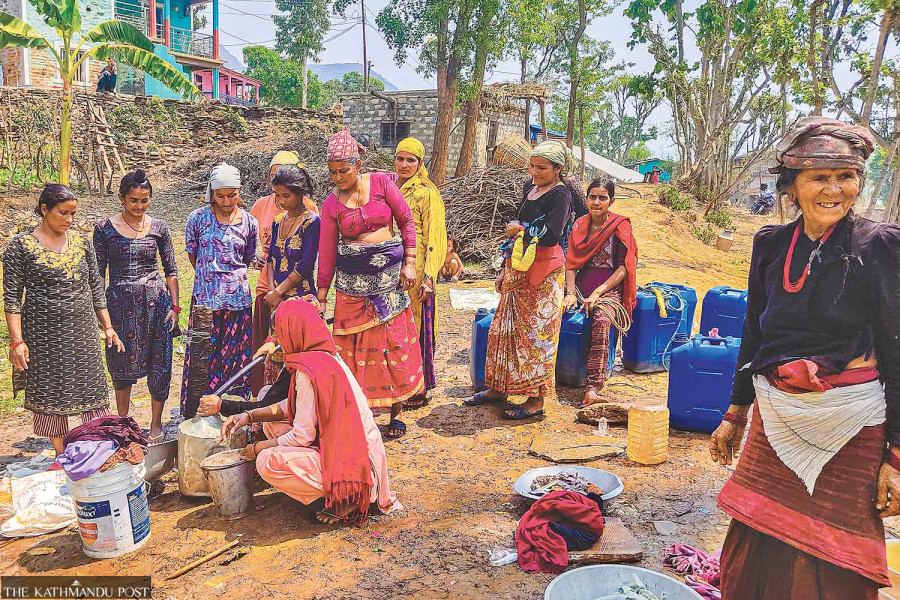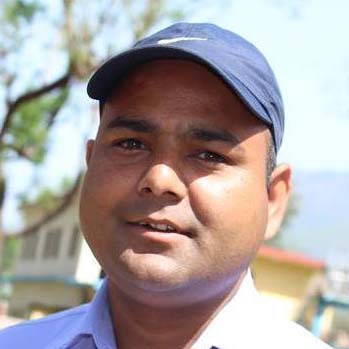National
Quake-hit Jajarkot villages reel under water shortage after sources dry up
The magnitude 6.4 earthquake last November damaged 480 drinking water projects in Jajarkot, Salyan, and Rukum West districts.
Krishna Prasad Gautam & Harihar Singh Rathour
The source of the Kapke Drinking Water Project in ward 9 of Barekot Rural Municipality dried up after the magnitude 6.4 earthquake jolted the area on November 3 last year. The water intake area subsided nearly by nearly one foot after the quake. There has been an acute shortage of drinking water in the Kapke area over the past seven months, leaving 120 households in hardships. The locals are forced to manage water from the Sidherikhola stream, which is around half an hour walk from the settlement.
“We have to be frugal in using water due to the water crisis in the area. The villagers are forced to wake up early to manage drinking water. The women and children spend the whole morning fetching water from the spring,” said Gajendra BK of Kapke.
Plight of the locals in Ghartigaun in ward 6 of Barekot and Bayala in ward 1 is also the same. Various settlements in the area are reeling under water crisis as the November 3 quake damaged drinking water projects. Around 200 families in Ghartigaun and Bayala are hugely affected. The villagers have no alternative than to go to the nearest streams or other water sources for drinking water.
“One gagri (water pot) of water that I fetch in the morning is hardly enough to prepare a morning meal and for drinking purposes. One has to be busy from dawn to dusk fetching water from the nearby spring after the earthquake damaged the drinking water project,” lamented Bimala Gharti of Barekot-6. “It is quite difficult to carry water uphill. And there is always the threat of wildlife attack as we have to go to the water spring in the wee hours,” she shared her ordeal.
Many water sources have dried up in the aftermath of the earthquake that hit Jajarkot, Rukum West and Salyan districts in the Karnali Province. According to the data available at the District Administration Office in Jajarkot, the sources of 143 drinking water projects dried up in the district after the November earthquake. Water supply has been disrupted in 106 drinking water projects as the quake caused substantial damage to reserve tanks and pipelines.
Nalgad Municipality is the hardest hit by the water crisis. There is an acute water shortage as 23 drinking water projects were destroyed while 26 others suffered partial damage in the natural disaster.
“Around 3,000 families of various settlements in Nalgad are reeling under an acute shortage of water. The villagers are forced to drink unsafe water from the Bheri river and other sources, exposing them to various water-borne diseases,” said Dambar Bahadur Rawat, deputy mayor of Nalgad. According to him, the number of patients suffering from diarrhoea and dysentery is rising in recent times, apparently due to drinking unsafe water.
According to Nalgad Municipal Hospital, around 150 patients visit the health institution on a daily basis now. “Most of the patients suffer from fever, diarrhoea, typhoid and common cold. Open defecation by the quake-displaced people living in temporary shelters causes serious health problems. There could be an outbreak of diarrhoeal diseases if the problem is not addressed immediately,” said Dr Bishal Uprety, chief at the hospital.
Around 8,000 temporary shelters, according to Rawat, were built in Nalgad Municipality. “Some people have been using old toilets while others defecate in the open,” said Rawat.
Bheri Municipality, located at the headquarters, is also facing a drinking water problem.
“There was always a shortage of drinking water in ward 4 of Bheri Municipality, but it was all manageable with the water from natural springs. Currently, everybody is forced to buy water for all purposes because all natural springs dried up after the earthquake,” said Basant Prasad Sharma, chairman of the ward.
Residents of Kudu in ward 13 of the municipality have been grappling with water shortages for years. A tap has been installed for nearly 300 families in Kudu after drilling a deep borewell.
“I wake up at 3:00 am in the morning and reach the tap to get in line because water is available only for a short time. When the tap runs dry, people are compelled to walk to the Bheri River three kilometres away, to fetch murky water,” said Sarita Rokaya, a local of Kudu who is living in a temporary shelter after her house was completely destroyed in the earthquake.
After the earthquake, nearly 80 percent of the locals of Kudu have migrated to temporary shelters made up of zinc sheets. Due to the shortage of drinking water, locals are forced to drink dirty and unsafe water.
“In the zinc sheet shelter it gets extremely hot during the day, we need more water to stay hydrated and for cleaning purposes. But there is not enough water,” Rokaya added.
Due to the lack of irrigation and drinking water, the locals of Kudu cultivate only summer crops. In order to solve the drinking water problem in Kudu, as part of the Integrated Karnali Irrigation Development Project, the government installed a deep borewell that could work using solar energy last year by spending Rs56.3 million.
Harka Bahadur Rokaya, another local of Kudu, said that after the earthquake, even the borewell is not pumping water like before.
In Jajarkot, despite being close to streams, rivers, and springs, everybody suffers from a drinking water shortage during the summer season.
Badri Pant, the chairman of ward 4 of Nalgad Municipality, said that after the earthquake, the water shortage has worsened in all the surrounding areas of the ward.
“All the springs slowly dried up after the earthquake, and the water level in the Bheri River is also very low. There is no alternative option except to use the murky water of the river,” said Pant. “Animal husbandry has also been greatly affected due to the water shortage,” Pant added.
Bir Bahadur Giri, chairman of Barekot Rural Municipality, said that plans are being made and prioritised to solve the problem of water shortage in the rural municipality.
“Along with other public structures, the earthquake has destroyed water supply projects in all wards, and we have accelerated the repair work on ten damaged projects, which is expected to be completed before the end of the current fiscal year,” said Giri.
“We have requested the provincial government to help us build a big drinking water project to solve the water scarcity problem in the municipality, but so far we have not received any reply,” said Chandraprakash Gharti, mayor of Bheri Municipality.
According to the Ministry of Water Resources and Energy Development of Karnali Province, the earthquake damaged 480 water supply projects in Jajarkot, Salyan, and Rukum West, and the loss caused to the projects has been estimated at Rs3 billion.
“The damaged projects will be reconstructed and repaired with the cooperation of the government of all three levels,” said Nabin Chandra Adhikari, secretary of the Ministry of Water Resources and Energy Development of Karnali Province.




 5.81°C Kathmandu
5.81°C Kathmandu
-(2).jpg)








%20(1).jpg&w=300&height=200)





